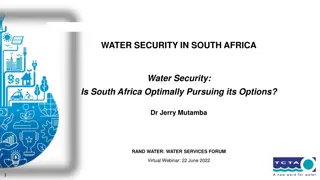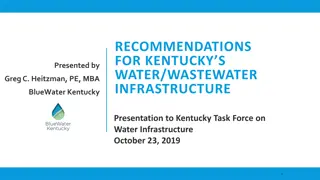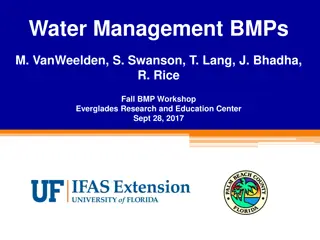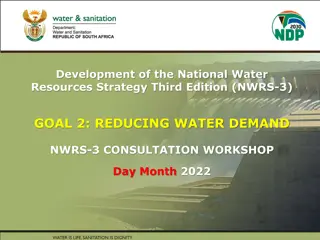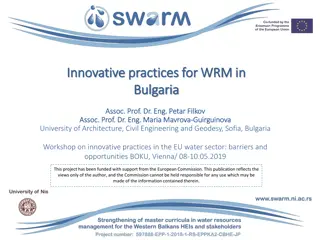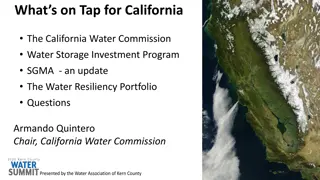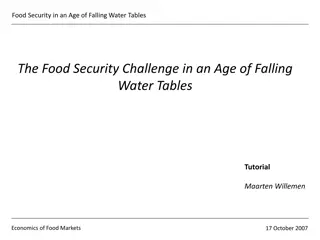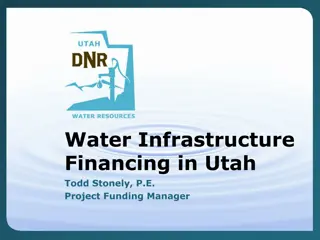Challenges and Solutions in California's Water Management
Addressing the complexities of water management in California, the article discusses statewide water usage, the Central Valley Project and State Water Project, existing water storage infrastructure, and new water storage projects developed since 1990. It highlights the balance between agricultural and urban demands, groundwater overdraft issues, surface water availability, and the need for sustainable solutions in the face of increasing water scarcity.
Uploaded on Sep 17, 2024 | 2 Views
Download Presentation

Please find below an Image/Link to download the presentation.
The content on the website is provided AS IS for your information and personal use only. It may not be sold, licensed, or shared on other websites without obtaining consent from the author. Download presentation by click this link. If you encounter any issues during the download, it is possible that the publisher has removed the file from their server.
E N D
Presentation Transcript
Can we dam our way to Paradise anymore? Some Supply-Side Meditations Valley Water Consortium H20 III, Distilling Sustainable Solutions March 10, Fresno City College, Social Science Building Presented by Ron Stork, Friends of the River
Statewide water use: 40/42 million acre-feet per year Demand profile: 80% agricultural, 20% urban Source: Roughly 50% groundwater, 50% surface water swinging with surface water availability
Central Valley Project (CVP): 7 million acre-feet per year deliveries 9 million acre-feet per year control Unpaid CVP reimbursable costs approximately $1.3 billion State Water Project (SWP): Average deliveries more than 2 million acre-feet/year Average Groundwater Overdraft 2 million acre-feet per year (mostly San Joaquin Valley)
Statewide Surface Storage 42 million acre-feet Central Valley Groundwater 683 million acre-feet (1975 California Water Atlas) Urban Southern California (San Gabriel, San Fernando, Santa Anna, San Jacinto river and mountain watersheds) 109 million acre-feet (1975 California Water Atlas)
California Water Storage Projects developed since 1990 (September, 2016) Project Size Description (acre-feet) Kern 2,500,000 Groundwater aquifer developed jointly by Kern County Water Agency, Kern Water Bank and the City of Bakersfield. Most of these supplies are used locally, but some of this water has been sold to other regions. Semi-Tropic 1,650,000 Groundwater storage, developed by Semitropic Water Storage District, serving as a water bank for a variety of agencies in northern and southern California. Additional capacity is available for new partners Diamond Valley 800,000 Surface reservoir built and paid for by Metropolitan Water District of Southern California (MWDSC) to improve dry-year reliability. Cal Fed Investigation Dams (Domenigoni) Arvin-Edison 350,000 Groundwater storage, developed by Arvin-Edison Water Storage District, serving as a water bank for MWDSC. Storage: Approximately 4 million acre-feet Urban Southern California Groundwater Local Groundwater Storage (Long Beach, Chino, Orange County, Compton etc.) Projects managed by Metropolitan Water District of Southern California. 212,000 Yield: Approximately 400 thousand acre feet average annual. (Sacramento Bee numbers here. Other estimates might nearly double this assessment.) Cost $8.9 billion (Sac Bee numbers) San Vincente Dam expansion Yuba 200,000 Additional groundwater storage developed by the Yuba County Water Agency. Los Vaqueros 160,000 Now 160,000 acre-foot surface reservoir to store delta diversions accomplished in two phases (so far) for Contra Costa Water District water quality 152,000 Now 242,000 acre-foot surface reservoir expanded by San Diego County Water Authority for Colorado River water Groundwater banking agreement developed in cooperation with San Francisco Public Utilities Commission. Representing an increase in statewide storage of 10% and increasing average annual water supply of 1% (or 2%). Daly City 60,000 Olivenhain Dam 24,000 San Diego County Water Authority surface reservoir for Colorado River water. Connection to Lake Hodges also allows storage of 20,000 acre-feet for emergency use Map courtesy of the Sacramento Bee 6,108,000 Total Surface storage total: 1,136,000 acre-feet Groundwater storage total: 4,972,000 acre-feet
Cal Fed-like Investigation Dams Storage: Approximately 4 million acre-feet proposed for study Yield: Approximately 500 thousand acre feet average annual increased deliveries. Cost $10.2 billion Representing an increase in statewide storage of 12% and increasing average annual water supply deliveries 1.25%.
Shasta Dam Raise (USBR): Final Feasibility Report July 2015 Final EIS Dec. 2015 No Recommended alternative Temperance Flat Dam (USBR) Draft Feasibility Report Jan. 2014 Draft EIS August 2014 Incomplete draft EIR submitted to CA Water Commission by SJVWIA
Third Los Vaqueros Dam raise (USBR/DWR/CCWD): Water Commission application Lots EIS/EIR work Probably will be a recommended alternative Sites Reservoir (DWR then Likely Sites Project JPA to take over): No Feasibility Report Administrative Draft EIR December 2013 Water Commission submission of DEIS/DEIR Likely to have an EIR with preferred alternative San Luis Dam raise: (USBR) Appraisal Report December 2013
Centennial Dam (Parker Dam on Bear River) (Nevada Irrigation District) Water Commission zero score, NID voted not to appeal CEQA NOP 2016 New Exchequer Dam (Merced Irrigation District) Dam raise (Congressional testimony to de-designate National Wild & Scenic River) Invasion of Corps of Engineers-required flood pool (Merced ID paper. No Water Commission application)
Estimated Cost: $1.3 billion Additional Capacity: 634,000 acre feet NED Project Average Annual Water Delivery Yield: 51,300 acre feet Water Beneficiaries: Apparently Westlands and Santa Clara Water Authority Key issue: Illegal under California law. Not eligible for bond subsidies
No legal cost-sharing partners No water rights to serve SWP Allocation of costs within CVP Illegal to construct, illegal to receive bond subsidies No support from resources agencies Native American cultural resources
Estimated Cost: $4.7 billion $4.2 billion CWC, $6.3 Fed estimate according to LA Times Capacity: 1.8 million acre feet Average Annual Water Supply Delivery Increase 273 thousand acre feet Sites Authority Draft EIR Water Beneficiaries: Area farmers, SWP & CVP urban water contractors, delta outflow Key issues: 1) Environmental protections for Sacramento River not established, 2) Cost and beneficiaries and cost-sharing partners (MWD not on board without tunnels).
Operating rules for diverting 5,900 cubic feet per second into reservoir don t exist Beneficiaries and water rights Financing Owner is likely to have to re-scope and begin new CEQA analysis with revised project description
Estimated Cost: $2.6 billion Storage Capacity: Up to 1.3 million acre feet Average Annual increased deliveries: (70,000 NED Project, Authority has plans for more if shared with westside and SWP/MWD) Key issue: River is fully appropriated, no water rights are available for storage legal operations by the Temperance Flat Dam
The Temperance Flat Dam will flood: 8 miles of the San Joaquin River Gorge a river recommended by the BLM for National Wild & Scenic River protection. A BLM recreation area visited by 84,000 people annually Three campgrounds, an outdoor education center and natural history museum Segments of San Joaquin River National Recreation Trail and two other National Trails
The Temperance Flat Dam will also flood: The unique Millerton Caves system A class III-V whitewater kayak run Habitat for many special status wildlife and plant species Many historical and cultural sites, some eligible for the National Register
Ownership. Beneficiaries. Financing. Likely loss of water to Friant Project customers. Allocation of costs within CVP Water rights (river system fully appropriated and Reclamation contemplates customers outside of CVP legal place of use) Native American cultural resources Environmental impacts and mitigation requirements. No support from natural resources agencies Special designations (BLM s Wild & Scenic River recommendation) Hydropower mitigation (PG&E s reaction to proposed mitigation for loss of powerhouses is unknown)
San Luis Dam Raise: No obvious project owner eligible for water bond funding Exchequer Dam: Raising dam violates the National Wild & Scenic Rivers Act and is therefore ineligible for bond funding. Invading flood reservation needs Corps of Engineers approval (at minimum). No formal applications have been made. Centennial Dam: $300 to $500 million dollar project whose principal feature is to legally capture water currently held by another water-right and dam owner. Nevada Irrigation District is on an aggressive schedule to complete EIR and EIS for needed permits. Tulare Lake: Use of Tulare Lake for floodflows and subsequent water use for potential CVP, SWP, local beneficiaries. A small host of small projects, often involving groundwater.
This concept is developed in Peak water limits to freshwater withdrawal and use by Gleick & Meena Palaniappan, Pacific Institute (the figures are from here) Key watersheds are on the right end of the potential production curve making potential watershed yield gains small
Key watersheds and key uses have reached the end of the cost-effectiveness of new-supply step- function curves
Public benefits do not include agricultural and municipal & industrial water uses. Water Commission staff seems disinclined to let supplicants just spin stories about their public benefit ideas
Responsible for allocating Prop. 1 funds for the environmental, water quality, and other public (taxpayer subsidized) benefits from new water surface or groundwater storage $2.7 billion is likely to be awarded on the basis of comparative value Likely to rely on EIRs from project proponents, but others can offer advice
Will decide the maximum conditional eligibility grants early this summer. Money is not awarded until EIRs are done and permits secured.
Whether the Commission is able to spend most of its money or not, the statewide supply and San Joaquin Valley groundwater overdraft realities won t be much affected much
The states recently passed groundwater legislation (SGMA) is going to force realistic assessments of groundwater and surface water availability and living within supply means The only realistic and sufficient tool for the big agricultural groundwater overdrafters will be demand reductions. Little can be done with supply augmentations. Urban water suppliers able to command higher retail prices for water will find investments in conservation, recycling, transfers, system repoerations, and yes, a little in storage (often groudwater) to be useful in increasing supply reliability and augmentations. Californian s will have to be creative, but solutions for most economically reasonable needs will find their way forward. The prospects for restoring key rivers and watersheds remain clouded and need to be addressed.
the problem isnt that we dont have enough reservoirs, the problem is that there isn t enough water in them. John Holdren, White House Science Advisor It s hard to dam your way to Paradise in California anymore. Ronald Stork, Friends of the River
For more information, contact: Steve Evans Consultant Friends of the River Phone: (916) 708-3155 Email: sevans@friendsoftheriver.org Ron Stork Senior Policy Advocate Friends of the River Phone: (916) 442-3155 x220 Email: rstork@friendsoftheriver.org For referenced fact sheets and other information on proposed dams, visit, www.friendsoftheriver.org













